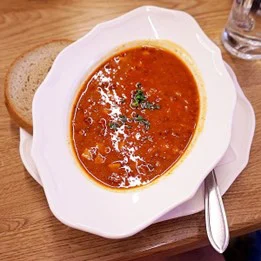In its translation from Hungarian, the dish is called “beef shepherd’s meat “.
In the vastness of the Hungarian Puszta, gulyas used to steam in cast-iron cauldrons.
A romantic idea.
But in this context, the historical background is essential for a better understanding of the origins of this dish: “Goulash, or gulyás, is a Hungarian national dish, the spice of which is paprika .
“A real Hungarian stomach can take a spoonful of paprika like confect, but the Germans burn with hellish fires at the same dose, which neither Bacchus nor Gambrinus can extinguish.” – Reason enough to treat every goulash in the pub with caution until it has proven not to be too spicy and therefore ready to be enjoyed.
(Julia Danielczyk, Isabella Wasner-Peter ed., “Heut muss der Tisch sich völlig bieg’n, Wiener Küche und ihre Kochbücher, Wien-Bibliothek im Rathaus, mandelbaum-verlag, page 34, Vienna, 2007). Goulash from Vienna did not establish itself as a fashionable dish that probably only became en vogue in the era of the fin de siecle.
No, in the wide-ranging history of old Austrian cookbooks, the preparation of “Kolaschfleisch” reads very familiar, without any “foreign” influence.
The cookbook author Anna Dorn mentions Hungarian kolash meat for the first time in her great Viennese cookbook of 1827 in the chapter entitled “Preserves”. A tasty but hearty type of this meat dish is known as “Fiakergulasch”, in which not only the sliced beef is served in its juice, but also a fried egg, a Frankfurter sausage and a gherkin sliced like a fan.
A hearty meal for the men who, yesterday as today, drive the typical Viennese horse-drawn carts through the city center. Time Travel Tip: In Peter’s Gulyas Beisl in Hütteldorfer Straße and in the Gulasch & Soehne Vienna restaurant in the Grand Hotel Ferdinand on Schubertring, this dish is prepared according to old recipes.
(Source: Wikipedia) Editor: Michael Ellenbogen

Maria Theresa’s children: the 16 descendants of the ruler
It is well known that Maria Theresa gave birth to 16 children. But who were they and what became of them? How many of them…


